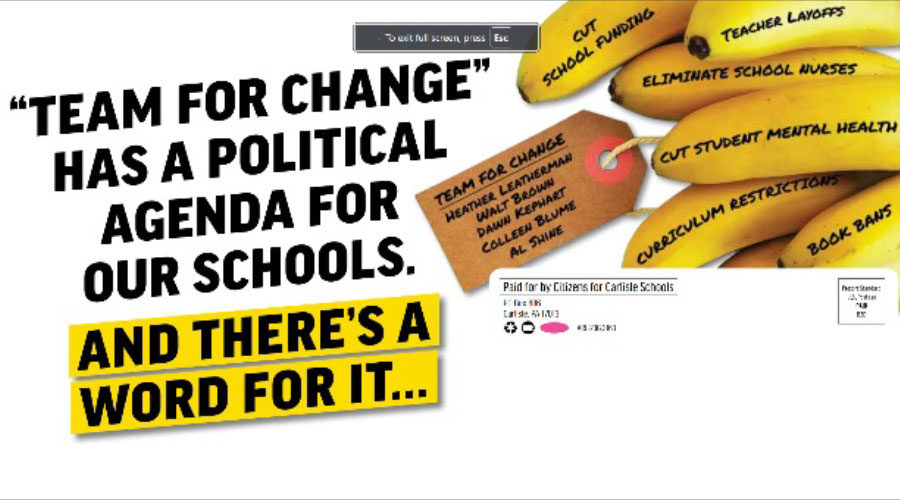CAMPAIGN STRATEGY
Win Number:
Winning is about getting more votes, nothing more or less than that. Understanding the population that votes in off-year local elections is critical as turnout can be extremely low (less than 35%). Knowing what percent of Democratic and Republican voters will be needed to win the primary is key to developing a strategy. For the general election, one will want to add Independent voters as part of their strategy. Developing a win number is looking back at the three most recent school board elections and averaging the number. If there is going to be anything else controversial on the ballot, the number to win should be increased, as controversary can bring out additional voters.
Strategy Development:
Most of the successful campaigns interviewed for this guide used canvassing, direct mail, social media (including digital ads), texting, and lawn signs to connect with voters. In campaigning a rule of thumb is that the average voter needs 6-10 touches to follow through and vote and those touches include door-to-door canvassing and all of the above-mentioned strategies.
Map out strategies and timing for both the primary and fall general elections. A campaign calendar can help the campaign stay on track. It also will help with budgeting and identifying timing of needed finances. Weekly or bi-weekly meetings of the candidates and key volunteers should include assessing metrics of the campaign—doors knocked, digital ads seen, fund raising, etc. Set goals and measure the results.
Checklist:
- Identify “ win numbers”
- Develop strategies to achieve those win numbers
- Door-to-door canvassing
- Attend local events
- Direct mail
- Post cards
- Digital ads
- Texting
- Phone calls to targeted voters
- Television ads
- Billboards
- Earned media – letters to editor and op-eds
- Create campaign calendar
Canvassing:
First and foremost, running for a local office involves building relationships. This includes going door-to-door and listening to voters concerns or thoughts about the school district. Building trust is a key aspect and relating to voters as someone who understands them can be critical. Door-to-door is the best place to use the personal stories that anchor an individual candidate’s reason for running and/or priorities once elected
“Voters are looking for someone authentic and relatable—I like you and feel you’ll make good decisions that are aligned with my values.”
Rick Galena
community volunteer
Carlisle Area School District
To support canvassing, voter lists can be accessed through a local party. Finding a volunteer who can “cut turfs” for door-to-door canvassing or learning how to cut turfs is helpful. A local political party will likely help with training or identifying an individual that knows how to use the voter database.
Canvassing is usually done on weekends, but depending on the area, late weekday afternoons are also good. A quick hand- written note on door hangers for those who aren’t home is a good way to show that you care about every voter. Pairing up a candidate with a volunteer can be useful to support canvassing training, garnering feedback, collecting data, and safety. Rural homes can be canvassed, and having a driver helps the candidate get to more homes in a rural area.
When running as a slate, a combined door hanger is helpful. The campaign team should also discuss whether individual candidates need their own leave behind for canvassing. Both pieces should be positive and consistent in messaging. Looking at materials used by other campaigns (check their social media or websites) also is helpful. The door hanger and candidate “leave-behind” for canvassing should include photos, bulleted biographies, a group picture of the slate, and the overall key messages of the campaign.
Expanding Reach:
Attending community events where you can either have a table, sponsor a float, or roam around and engage attendees in conversation is useful. Building out one’s network of friends, neighbors, and/or fellow parents in PTOs or booster organizations is useful in building an email list, texting, and cultivating participation on social media. Reaching out to people in the faith community can also be helpful in that candidates taking extreme positions often use their churches to get their message out to those most upset with public education.
Website and Social Media:
Campaigns – whether a single candidate or a slate of candidates – must have a website. The website should address who the candidate or group is, what their priorities are, list upcoming events, and have landing spots for individuals to volunteer and donate. Checking out the opposition’s website is important to understand what they are saying. Developing the campaign’s identity on the website is a good start, but equally important is making sure that content is maintained and links work.
Social media allows for a more personable look at candidates and the campaign. Facebook is typically the most commonly used social media for local elections given the age of most off-year election voters; however, other social media (TikTok, Instagram, and X or Twitter) is helpful in larger districts and in particular, reaching younger voters.
Central Bucks School District Neighbors United for School Board Candidates used strong visuals and consistent messages in its social media posts.
Facebook postings should be done frequently and include pictures, videos, digital ads, information on the candidates, graphics, strong campaign messages, and important election information. Facebook allows for the use of storytelling through pictures and videos. Facebook posts also can link to the website, particularly in securing volunteers and donations.
Establishing a social media plan enables more effective execution and should include:
- Establishing group rules that address what can be posted and behavior of members in commenting.
- Daily posting that maximizes the likelihood of viewing by understanding the timing of traffic on the page and posting at those times.
- Setting goals, including increasing followers, impressions, and donations.
- Periodic evaluation of what generates the most engagement.
- Keeping posts short and focused and supporting posts with pictures, branding, and graphics.
- Enabling engagement that motivates an individual to comment, sign up for an event, and/or donate.
- Identifying a moderator to review requested posts, to make sure comments are acknowledged and/or responded to, and that anyone violating the group’s rules is blocked.
Traditional Media:
Reaching voters in the current media market is challenging. Unless a market includes a local TV station, TV ads are not necessarily worth the expense in many of the state’s school districts. While readership in newspapers has declined, older voters still read newspapers and so developing a relationship with the reporter covering school boards is helpful as is meeting with the paper’s editorial board. Most newspapers do produce voter guides and making sure that pictures and answers to questions are developed thoughtfully is essential. Campaigns in larger districts reported using ads in newspapers as part of their strategy.
There also will be “earned media” opportunities that occur through sitting with a local paper’s editorial board, having supporters write letters to the editor of the local paper, participating in campaign forums or other meet and greets offered by local organizations, such as the League of Women Voters, AAUW, local chapters of the political parties, or other events. The campaign strategy should also map out timing of these events and coordination of message.
Mail:
Direct mail enables campaigns to target specific messages to specific voters. Pictures and strong visuals are critical to drawing the reader’s attention. Crisp messages are the most beneficial. Mailers provide the means for being able to distinguish your slate of candidates from the opposition. Being able to download voter lists so that the printer can use them in mailing is necessary.
Campaigns also use postcards. The postcards, developed by the campaign team, should include the candidate names, pictures, and overall message. Volunteers are then involved to add a personalized message to the voters from a campaign suggested message or messages. Addressing the postcards by hand is an individual touch and helps attract the reader to the handwritten message. Use underlining and colors for additional touches. Postcard writing parties are an effective way to bring campaign volunteers together and for them to interact with candidates. Campaigns may provide the stamps, or the volunteers may provide stamps. If the latter is chosen, volunteers need to report on the cost of the stamps as an in-kind donation.
Central Bucks School District Neighbors United for School Board Candidates used strong visuals and consistent messages in its social media posts.
Texting:
Texting has become a critical part of getting out the vote (GOTV). Texting is fairly inexpensive and allows messages to be targeted to specific demographic groups. Digital ads are also useful in the GOTV phase of a campaign as they can be targeted geographically and are also fairly inexpensive to run. A volunteer or paid individual with digital design experience is helpful in making quality videos or ads. Campaign videos can then be posted to Facebook and/or texted to likely voters.
Yard Signs and Billboards:
Yard signs are viewed to be more helpful for down ballot races, such as school boards. They can help build name recognition as well as reinforce that individuals running for local office are the best candidates. In Pennsylvania, individuals can place signs on their properties for months prior to an election, whereas signs in public right of ways can only be placed 30 days prior to elections. Thinking about sign placement strategically is important because yard signs can be expensive.
Billboards, if located in a high traffic area, can be useful in supporting a campaign. As with any other type of communication piece, less is more as individuals will not have time to absorb a complex message when driving by the billboard.
“Parent coalitions can help educate the public about the harms occurring because of an extremist board, thus highlighting the need for new board members.”
Jane Cramer
parent advocate
Pennridge School District
Endorsements:
Part of strategy development is considering use of endorsements, such as other locally elected individuals (mayors, borough council members, county commissioners, state representatives or senators); statewide or regional groups that support public education (local bargaining unit, parent groups); and local or county political organizations. Reaching out to both parties should be considered, if, for no other reason, to be able to say that the campaign tried. Deciding how best to use endorsements and whether endorsements included funding support for the local PAC are also considerations. In larger school districts, being willing to work with other groups and build coalitions in support of public education is helpful in identifying potential voters, volunteers, and donors. Campaigns need to consider how to engage retired educators and/or educators at institutions of higher learning as these individuals generally have an interest in supporting public education.
Get Out the Vote:
Primary and general election days are an opportunity for one last connection with voters. Having candidates and volunteers greet voters at the polls sends a strong message of caring about voters and making sure that they matter. A simple handout of the candidate names is useful to give voters who may need help remembering the full slate. Wearing a T-shirt or sweatshirt branded with candidate or slate names provides a visual for anyone arriving at the polling place. Thanking all voters for coming and voting is thoughtful and appreciated.
Volunteers:
Part of successful campaigns was garnering volunteer support. Canvassing is typically the area where volunteers are needed the most. Having volunteers at polling places to greet and thank voters is helpful as well.
Identifying a volunteer with communication experience, a volunteer with photography experience, and a volunteer or college intern with social media skills can be helpful in developing the campaign’s print materials, website, and social media.
Thank Yous:
A final campaign reminder is that as you proceed through the campaign to follow up with thank you notes, including to those individuals who signed your ballot petition, campaign contributors, to volunteers, and ultimately the voters (posting your thank you on social media or through a letter to the editor of the local newspaper).
Final Word on Strategy:
Ultimately campaigning is about building connections so that voters will trust you as a candidate and the team you are running with. Unless there is no opposition, all of those interviewed said that the days of not campaigning are long gone. Voters need to know who you are and what you plan to do and why the opposition won’t do that and that requires a clear campaign strategy.





